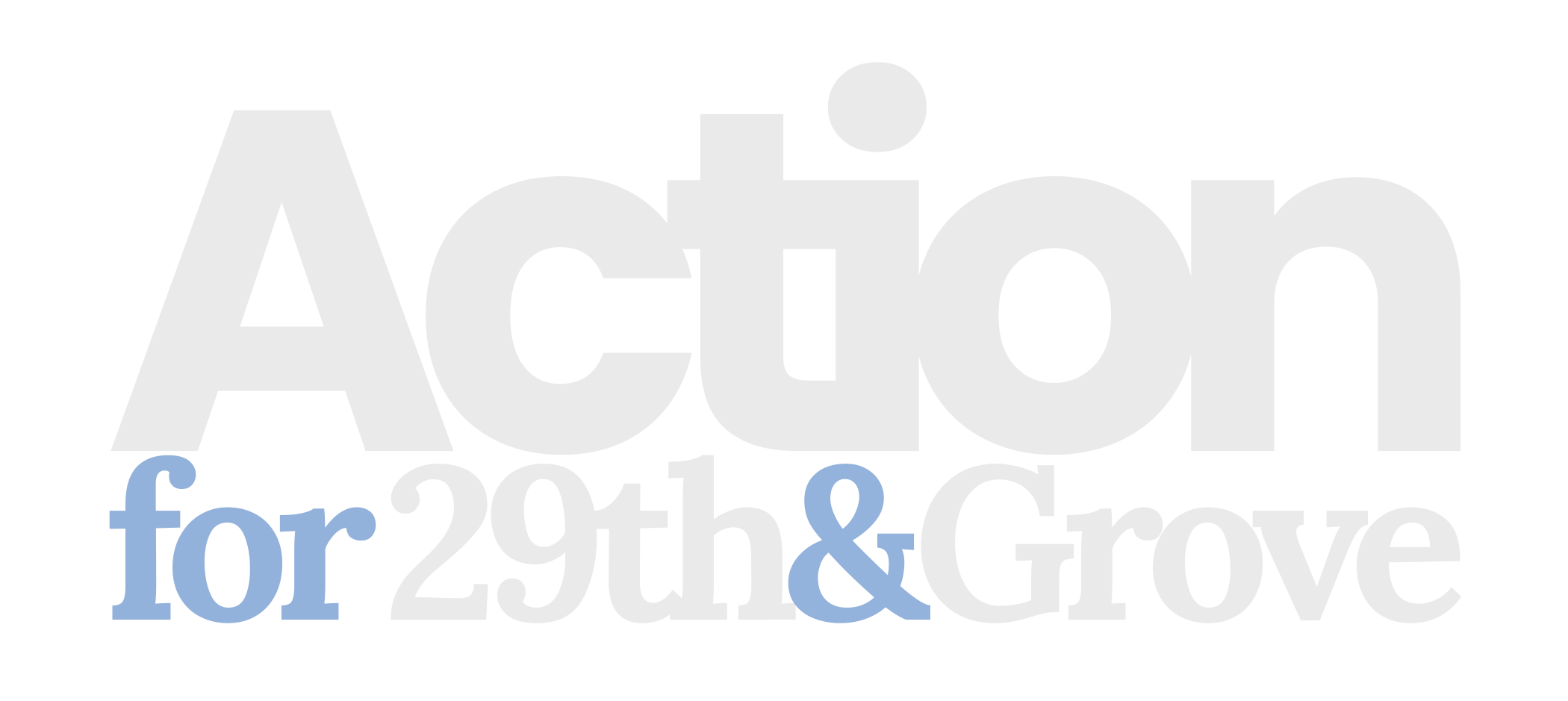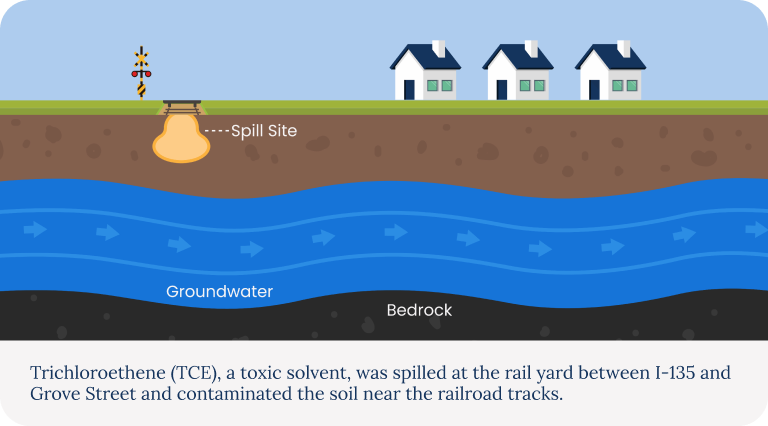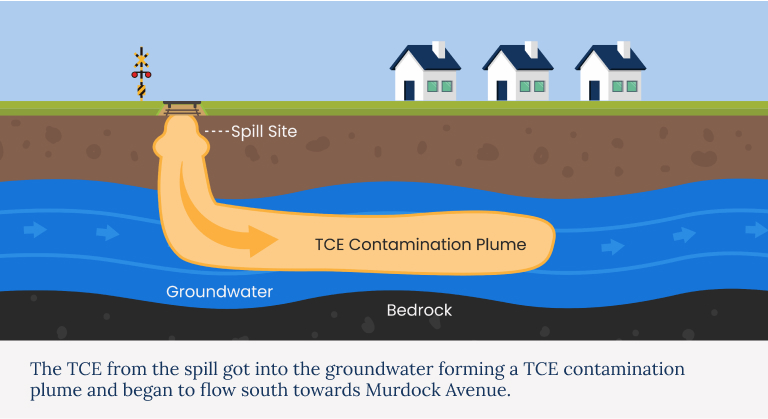29th & Grove Site Overview
In the 1990s, a chemical spill involving trichloroethylene (TCE) was discovered at the site. The exact cause and date of the spill are unknown. TCE is an industrial solvent used for cleaning metal parts and found in some household products, such as paint removers, spot removers and cleaning and furniture care products. Since discovery of the spill, Union Pacific has been working under the guidance and supervision of the Kansas Department of Health and Environment (KDHE) on testing and cleanup efforts.
Following a KDHE-approved work plan, Union Pacific conducted thousands of tests of groundwater, soil, outdoor and indoor air, and successfully performed a range of remediation efforts to safeguard the community.
We removed contaminated soil from the source area near our railyard and installed a groundwater cleanup system to control, remove, and treat contaminants. We also put in a network of monitoring wells to help track cleanup progress and check if the contamination plume is moving. These monitoring wells show that the plume has not expanded.
To help contain and treat the plume, we use a method called pump and treat. This involves pumping contaminated groundwater out of the ground and treating it to remove contaminants. This method captures the plume before it can spread further south.
Significant progress has been made in remediating the source area, leading to a decrease in TCE levels in the groundwater. Taking action to protect the community has been our priority since our work began over 20 years ago and that remains true today. Union Pacific remains committed to continuing cleanup efforts and delivering lasting solutions.
Final Phase Cleanup Timeline
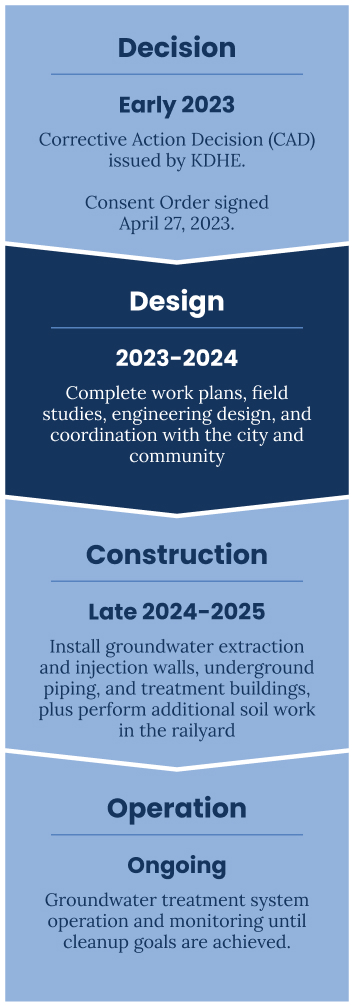
In early 2023, the Kansas Department of Health and Environment KDHE approved a general cleanup plan that will take place over several years. This plan includes using natural processes to break down pollutants, removing polluted soil, and cleaning up contaminated groundwater. A legal agreement was signed in April 2023 allowing us to start detailed planning, field studies, and discussions with the community. Construction is expected to start in late 2024 and involves installing wells, pipes, and treatment facilities. Following construction, we will begin a long-term operating phase, cleaning the groundwater and monitoring the site until cleanup goals are met. This structured approach provides a thorough and safe cleanup process.
KDHE Oversight
The Kansas Department of Health and Environment (KDHE) plays a critical role in the environmental cleanup project at the 29th and Grove site. As the regulatory authority, KDHE oversees the project to maintain compliance with environmental laws and safety standards.
KDHE issued the Corrective Action Decision, which outlines the approved methods and objectives for the cleanup, including bioremediation, soil removal, and groundwater treatment. KDHE also monitors Union Pacific’s ongoing work to ensure it meets defined environmental and health standards.
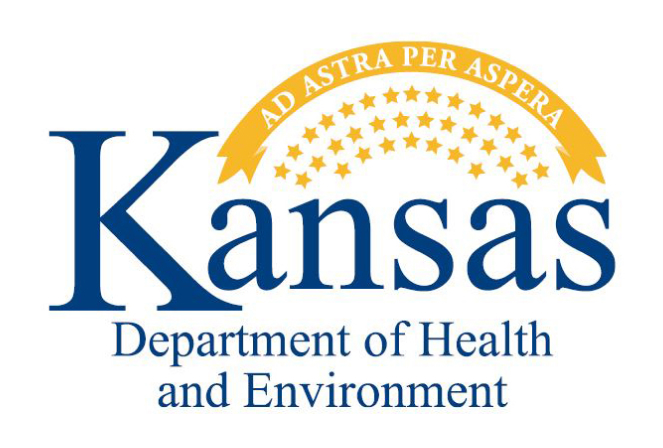
Cleanup Technologies
Our Cleanup Strategy at 29th and Grove: The remediation work at the 29th and Grove site includes a variety of advanced cleanup technologies, including monitoring wells, groundwater extraction systems, soil excavation, enhanced microbial remediation techniques, and soil gas sampling. This scientifically backed strategy is designed to contain and treat the contaminated areas, closely monitor progress, and ultimately achieve a thorough and lasting cleanup.
Monitoring Wells
To track cleanup progress and monitor the groundwater quality, we installed 65 wells. These monitoring wells allow us to regularly collect and analyze groundwater samples to check the effectiveness of cleanup efforts.
Groundwater Extraction Wells
We installed six groundwater extraction wells designed to prevent further spread of the contaminated groundwater plume. These wells work by extracting and containing the contaminated groundwater, preventing it from migrating to unaffected areas and protecting the surrounding environment. Additional groundwater extraction wells will be added as part of the final remedy when approved by KDHE.
Soil Excavation
Approximately 1,200 tons of impacted soil were carefully excavated and safely removed from the site to address contaminated soil. This proactive measure involved identifying and extracting soil with potentially harmful substances. More soil excavation activities are planned as part of ongoing cleanup.
Enhanced Microbial Remediation
In 2018, we began implementing an innovative approach called Enhanced Microbial Remediation. This accelerates naturally occurring microbes in the soil to destroy pollutants from both the soil and groundwater through biological processes, gradually restoring the site over time.
Soil Gas Samples
In early 2024, we conducted soil gas sampling activities in collaboration with the city and local community. This process involved testing and analyzing soil vapors from various locations to identify potential sources of contamination and whether vapor has the potential to impact indoor air. The soil gas sampling data provided valuable insights for a comprehensive approach to the monitoring and remediation efforts.
Important Words to Know
Groundwater
water found underground between soil, sand and rocks.
Groundwater Plume
a moving area of contaminated groundwater extending from a pollution source and carrying pollutants with it.
Groundwater Sampling
gathering underground water samples from multiple locations in an area to test for pollutants.
Remediation
the process of improving or correcting a situation.
Soil Gas (or Vapor)
gas in the spaces between pieces of soil, originating from natural sources, or pollutants.
Trichloroethylene (TCE)
a common man-made chemical widely used in industrial work for degreasing metal parts and dry-cleaning fabrics.
Vapor Intrusion
a process in which gases containing chemicals move through soil or pipes and enter buildings, potentially impacting indoor air quality.
Vapor Testing
a method used to check for of potentially harmful gases or vapors in soil, buildings, or air.
